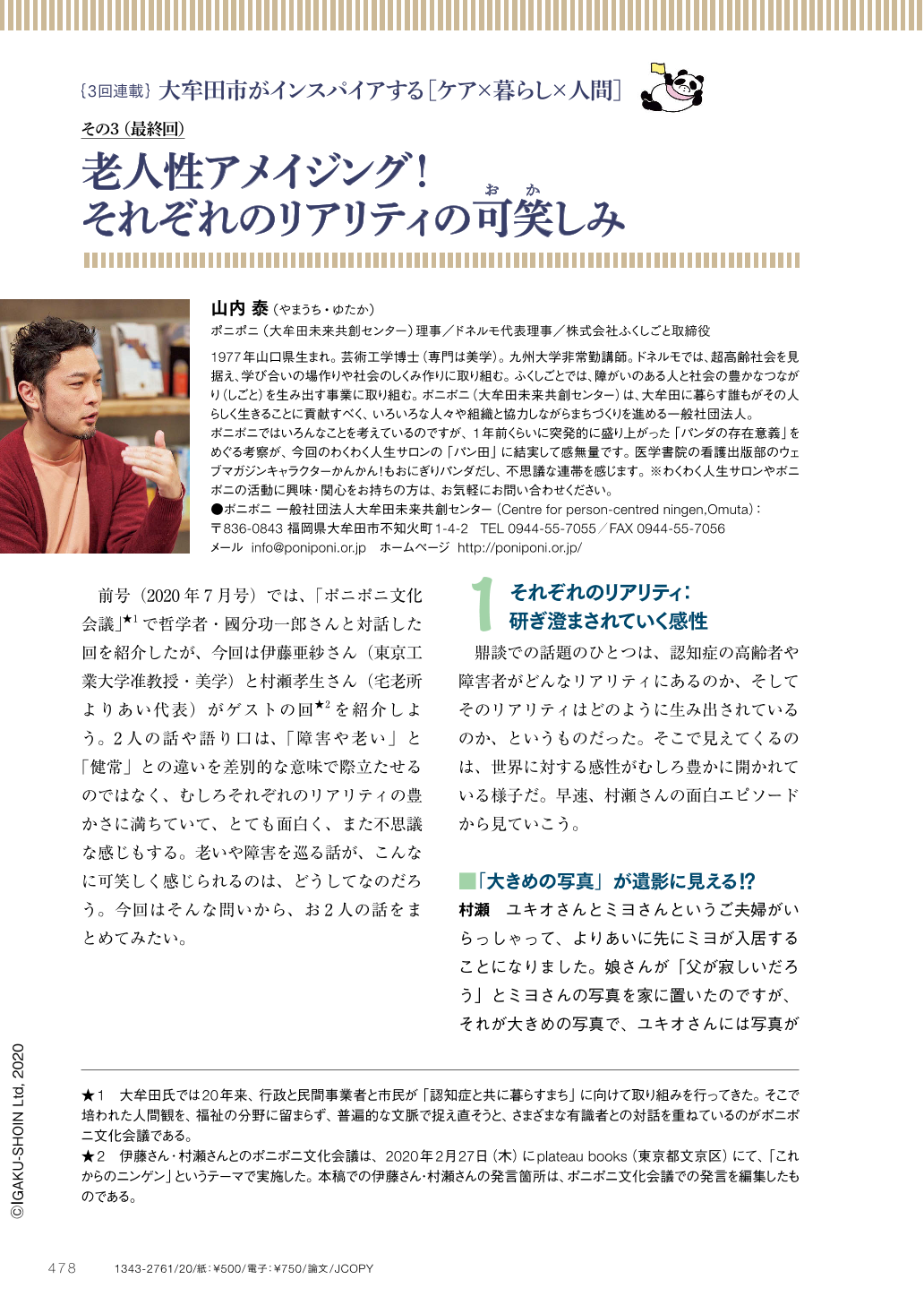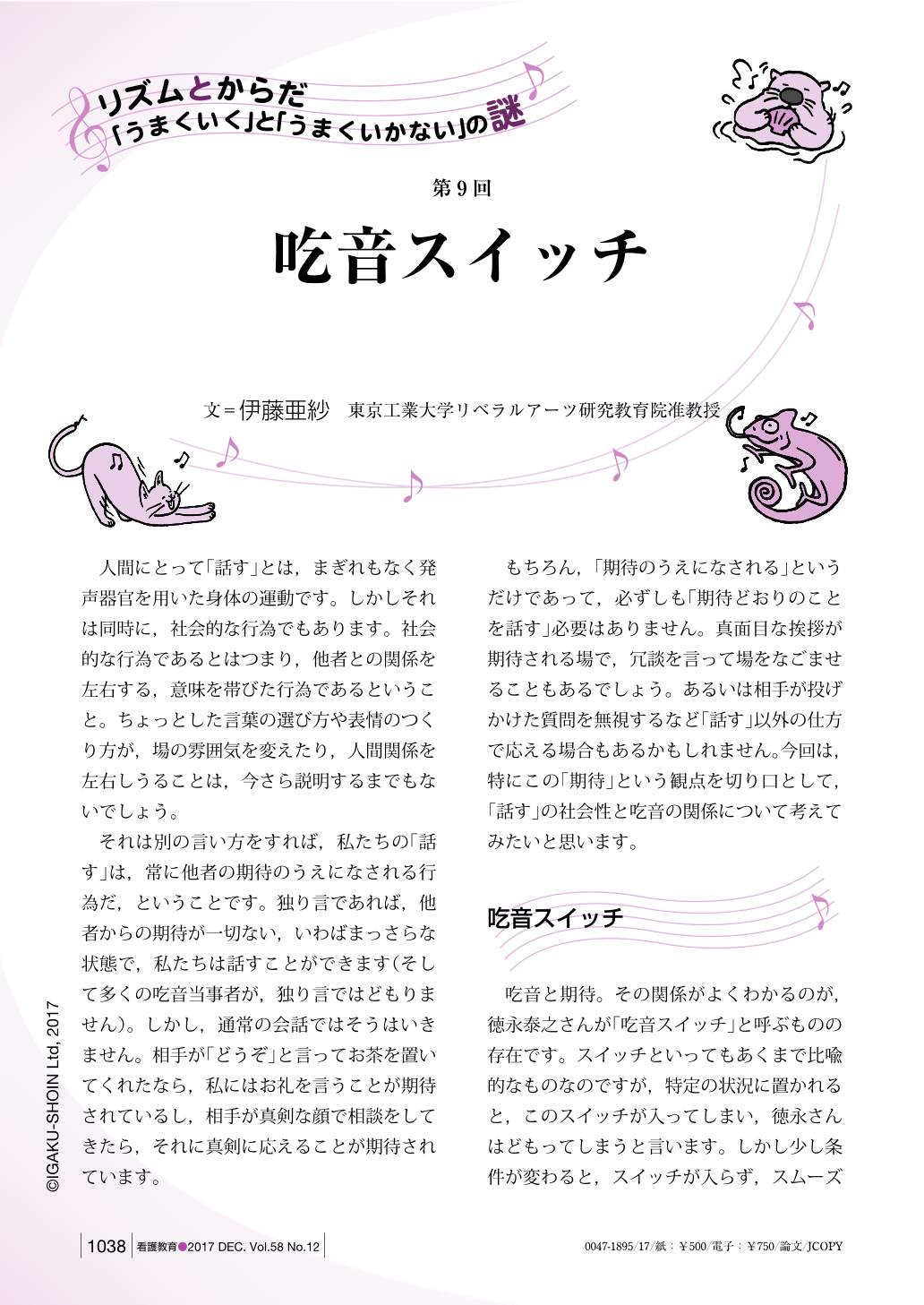4 0 0 0 OA 描写なき文学としての詩 : ヴァレリーにおける読者の身体の主題化
- 著者
- 伊藤 亜紗
- 出版者
- 美学会
- 雑誌
- 美學 (ISSN:05200962)
- 巻号頁・発行日
- vol.62, no.1, pp.1-12, 2011-06-30
The aim of this paper is to investigate Paul Valery's criticism of description in literature and to clarify his ideal of poetry. Description is a technique to represent an object visually. Though an author chooses arbitrarily what he/she describes, he/she expects his/her reader to abstain the self and to obey him/her. Valery criticized this passiveness of reader and dominance of author. For Valery both reader and author have productive roles and they are completely separated two systems just like a producer and a consumer in a market economy. Through an act of reading, a reader finds abilities of his/her body which were unknown to himself/herself. This focusing on a reader's body is an ideal effect of poetry for Valery. While description involves a false reality, a pure poetry explores a reality of body. A work is not a messenger of feelings or thoughts of an author but a machine to make a reader's body act. A comparison with Breton's solution will make points of Valery's discussion more clear.
3 0 0 0 OA 当事者の経験にもとづく視覚障害者の身体論
- 著者
- 伊藤 亜紗
- 出版者
- 美学会
- 雑誌
- 美学 (ISSN:05200962)
- 巻号頁・発行日
- vol.68, no.2, pp.1, 2017 (Released:2019-01-02)
This paper aims to clarify characteristics of aesthetic experience of blind people. Aesthetics has long treated the blind as people who have extraordinary ability of sense of touch under the strong influence of Molyneux’s problem. As Derrida advocated, sense of touch has played a fundamental role in the tradition of Western metaphysical thought because it can grasp an essence directly without any interference of preconception. This study questions this connection between blind people and sense of touch by conducting field research. The result of interview shows that blind people rather tend to avoid to touch objects by hand so as to follow the code of conduct of sighted people. Instead, they like to use another sense modality such as audition or sense of smell. Of course they sometimes rely on sense of touch too, but the way of using it is completely different from what aesthetics has expected to be. This misunderstanding about blind people was strengthened because aesthetics has referred to them only in the limited context and has paid little attention to their real life. This paper argues the possibility of aesthetical approach to handicapped people and evaluates its significance from the viewpoint of disability studies.
3 0 0 0 OA 身体の個別性に向き合う
- 著者
- 伊藤 亜紗
- 出版者
- 日本認知科学会
- 雑誌
- 認知科学 (ISSN:13417924)
- 巻号頁・発行日
- vol.29, no.2, pp.295-302, 2022-06-01 (Released:2022-06-15)
- 参考文献数
- 8
The diversity of human bodies is often omitted by academic research as well as by the social system because it is more likely to focus on deducing general theories. This paper takes the visually impaired for instance to spell out the points that must be paid attention to cover the diversity of their (in)visuality. We tend to think that the body of someone without impairment is a complete whole and that the body with impairment is an uncomplete one from which some kind of function is somehow missing. However, one's own body is something that generates a unique meaning, in terms of its relationship to the surrounding environment. The uniqueness of each body cannot be expressed by any numerical indicator. The person-centered approach that does not separate the impairment from the living body is necessary.
2 0 0 0 OA 描写なき文学としての詩 : ヴァレリーにおける読者の身体の主題化
- 著者
- 伊藤 亜紗
- 出版者
- 美学会
- 雑誌
- 美学 (ISSN:05200962)
- 巻号頁・発行日
- vol.62, no.1, pp.1-12, 2011-06-30 (Released:2017-05-22)
The aim of this paper is to investigate Paul Valery's criticism of description in literature and to clarify his ideal of poetry. Description is a technique to represent an object visually. Though an author chooses arbitrarily what he/she describes, he/she expects his/her reader to abstain the self and to obey him/her. Valery criticized this passiveness of reader and dominance of author. For Valery both reader and author have productive roles and they are completely separated two systems just like a producer and a consumer in a market economy. Through an act of reading, a reader finds abilities of his/her body which were unknown to himself/herself. This focusing on a reader's body is an ideal effect of poetry for Valery. While description involves a false reality, a pure poetry explores a reality of body. A work is not a messenger of feelings or thoughts of an author but a machine to make a reader's body act. A comparison with Breton's solution will make points of Valery's discussion more clear.
2 0 0 0 OA 障害と美学 : 身体論的な観点から(第六十六回美学会全国大会発表要旨)
- 著者
- 伊藤 亜紗
- 出版者
- 美学会
- 雑誌
- 美学 (ISSN:05200962)
- 巻号頁・発行日
- vol.66, no.2, pp.116, 2015-12-31 (Released:2017-05-22)
2 0 0 0 OA 身体を運動させる空間-トリシャ・ブラウンのダンスとドローイング
- 著者
- 伊藤 亜紗
- 出版者
- 舞踊学会
- 雑誌
- 舞踊學 (ISSN:09114017)
- 巻号頁・発行日
- vol.2008, no.31, pp.1-9, 2008 (Released:2010-04-30)
Trisha Brown, who is a founding member of Judson Dance Theater, has been interested in the relation between the moving body and the surrounding space—the space not only as room in which the body moves but also as device which instructs and inspires the body how to move. As the minimalist object is the function of the space, her dance is highly influenced by the condition of what is surrounding the body. The aim of this paper is to focus on this relation examining her different but connecting two fields of practice that is to say dance and drawing.Many of Brown's drawings are drawn with one stroke, where the line on paper is the trace of continuous movement of body. The aesthetical criteria look less important. Nevertheless the eye plays leading role there, because some rules concerning the points to pass are given. The hand led by eyes must choose one point to pass among the apexes of imaginary grid each time. This game-like drawing keeps her conscious of present.The same approach can be seen in her dance piece. In Locus (1975), Brown invented “Imaginary cube.” The dancer is at the center of Imaginary cube and touches each apexes according to the given order. By doing so, she unexpectedly leave dance between two apexes. The rule is not in dancer but in space, and the dancer keeps referring to the cube around her. Dancer's body is now free of role of expressing any idea. On the other hand, Imaginary cube works as tool to invent choreography.Since 1979, Brown has given performances at theater with proscenium arch. She questions the theatrical space and tries to turn its stressing atmosphere into advantage. For example she invents the floor pattern according to which one dancer's movement interferes with another dancer's movement. The space with some rules can be used as device to make dance.
- 著者
- 伊藤 亜紗
- 出版者
- 東京大学大学院人文社会系研究科・文学部美学芸術学研究室
- 雑誌
- 美学藝術学研究 (ISSN:13426095)
- 巻号頁・発行日
- vol.28, pp.61-83, 2010-03-29
- 著者
- 茂木 一司 布山 毅 廣瀬 浩二郎 伊藤 亜紗 手塚 千尋 宮本 聡 大内 進 笠原 広一 池田 吏志 山城 大督
- 出版者
- 跡見学園女子大学
- 雑誌
- 基盤研究(B)
- 巻号頁・発行日
- 2021-04-01
視覚障害教育は粘土造形による「触る美術教育」として発展・認知されてきたが,近年対話型鑑賞などによる「触らない=言葉による鑑賞」が注目を集めはじめ,二極化もみられる。本研究は,そのような触る/触らない、もの/テキストなど視覚障害美術教育における二元論的な対立を回避し,見えない人も見える人も「ともに歩めるインクルーシブアート教育」の理念と具体的なアナログ・デジタルメディアを使った題材・教材およびカリキュラム作成をめざして,取り組む実験的な研究である。
1 0 0 0 老人性アメイジング! それぞれのリアリティの可笑しみ
前号(2020年7月号)では、「ポニポニ文化会議」★1で哲学者・國分功一郎さんと対話した回を紹介したが、今回は伊藤亜紗さん(東京工業大学准教授・美学)と村瀬孝生さん(宅老所よりあい代表)がゲストの回★2を紹介しよう。2人の話や語り口は、「障害や老い」と「健常」との違いを差別的な意味で際立たせるのではなく、むしろそれぞれのリアリティの豊かさに満ちていて、とても面白く、また不思議な感じもする。老いや障害を巡る話が、こんなに可笑しく感じられるのは、どうしてなのだろう。今回はそんな問いから、お2人の話をまとめてみたい。
- 著者
- 伊藤 亜紗
- 出版者
- 美学会
- 雑誌
- 美学 (ISSN:05200962)
- 巻号頁・発行日
- vol.63, no.2, pp.118, 2012-12-31 (Released:2017-05-22)
- 著者
- 伊藤 亜紗
- 出版者
- 美学会
- 雑誌
- 美学 (ISSN:05200962)
- 巻号頁・発行日
- vol.60, no.1, pp.201-202, 2009-06-30 (Released:2017-05-22)
1 0 0 0 OA ヴァレリーにおける詩の「純粋性」と身体への生理学的関心
- 著者
- 伊藤 亜紗
- 出版者
- 美学会
- 雑誌
- 美学 (ISSN:05200962)
- 巻号頁・発行日
- vol.57, no.4, pp.15-28, 2007-03-31 (Released:2017-05-22)
What I try to indicate in this paper is that what Paul Valery called 'pure poetry' concerns the 'physiological' sensation of the body that cannot be conveyed by prose. Curiously Valery found the ideal type of art experience in the physiological phenomena due to the nature of retina-that is to say perception of complementary colors. Complementary colors produced by the eye as antidote against colors that stimulate itself are certainly subjective impressions and imply fear of disturbing objective recognitions. However, Valery regards this pure sensation which is set free from external objects to refer, as a perception of our own body whose functions are normally imperceptible to us. We directly find out about our body only when it doesn't function properly. By using means such as rhythm, rhyme, inversion and surprise, poetry captures and restrains the reader's body and interferes its smooth and automatic that is to say prosaic activity. This is the point where pure poetry and the physiology intersect. Both, guiding our attention to physical disorder, help us to gain the representation of our body, which, according to Valery's idea, is a system consisting of various functions.
- 著者
- 伊藤 亜紗
- 出版者
- 美学会
- 雑誌
- 美学 (ISSN:05200962)
- 巻号頁・発行日
- vol.57, no.3, pp.52, 2006-12-31 (Released:2017-05-22)
1 0 0 0 当事者の経験にもとづく視覚障害者の身体論
- 著者
- 伊藤 亜紗
- 出版者
- 美学会
- 雑誌
- 美学 (ISSN:05200962)
- 巻号頁・発行日
- vol.68, no.2, 2017
This paper aims to clarify characteristics of aesthetic experience of blind people.Aesthetics has long treated the blind as people who have extraordinary ability of senseof touch under the strong influence of Molyneux's problem. As Derrida advocated, senseof touch has played a fundamental role in the tradition of Western metaphysical thoughtbecause it can grasp an essence directly without any interference of preconception. Thisstudy questions this connection between blind people and sense of touch by conductingfield research.The result of interview shows that blind people rather tend to avoid to touch objectsby hand so as to follow the code of conduct of sighted people. Instead, they like to useanother sense modality such as audition or sense of smell. Of course they sometimesrely on sense of touch too, but the way of using it is completely different from whataesthetics has expected to be.This misunderstanding about blind people was strengthened because aesthetics hasreferred to them only in the limited context and has paid little attention to their real life.This paper argues the possibility of aesthetical approach to handicapped people andevaluates its significance from the viewpoint of disability studies.
1 0 0 0 吃音スイッチ
- 著者
- 伊藤 亜紗
- 出版者
- 医学書院
- 雑誌
- 看護教育 (ISSN:00471895)
- 巻号頁・発行日
- vol.58, no.12, pp.1038-1041, 2017-12-25
人間にとって「話す」とは,まぎれもなく発声器官を用いた身体の運動です。しかしそれは同時に,社会的な行為でもあります。社会的な行為であるとはつまり,他者との関係を左右する,意味を帯びた行為であるということ。ちょっとした言葉の選び方や表情のつくり方が,場の雰囲気を変えたり,人間関係を左右しうることは,今さら説明するまでもないでしょう。 それは別の言い方をすれば,私たちの「話す」は,常に他者の期待のうえになされる行為だ,ということです。独り言であれば,他者からの期待が一切ない,いわばまっさらな状態で,私たちは話すことができます(そして多くの吃音当事者が,独り言ではどもりません)。しかし,通常の会話ではそうはいきません。相手が「どうぞ」と言ってお茶を置いてくれたなら,私にはお礼を言うことが期待されているし,相手が真剣な顔で相談をしてきたら,それに真剣に応えることが期待されています。
1 0 0 0 OA 「関係性の美学」の演劇的性格
- 著者
- 伊藤 亜紗
- 出版者
- 東京大学大学院人文社会系研究科・文学部美学芸術学研究室
- 雑誌
- 美学藝術学研究 (ISSN:13426095)
- 巻号頁・発行日
- vol.30, pp.23-44, 2012-03-23
1 0 0 0 OA ヴァレリーにおける詩の「純粋性」と身体への生理学的関心
- 著者
- 伊藤 亜紗
- 出版者
- 美学会
- 雑誌
- 美學 (ISSN:05200962)
- 巻号頁・発行日
- vol.57, no.4, pp.15-28, 2007-03-31
What I try to indicate in this paper is that what Paul Valery called 'pure poetry' concerns the 'physiological' sensation of the body that cannot be conveyed by prose. Curiously Valery found the ideal type of art experience in the physiological phenomena due to the nature of retina-that is to say perception of complementary colors. Complementary colors produced by the eye as antidote against colors that stimulate itself are certainly subjective impressions and imply fear of disturbing objective recognitions. However, Valery regards this pure sensation which is set free from external objects to refer, as a perception of our own body whose functions are normally imperceptible to us. We directly find out about our body only when it doesn't function properly. By using means such as rhythm, rhyme, inversion and surprise, poetry captures and restrains the reader's body and interferes its smooth and automatic that is to say prosaic activity. This is the point where pure poetry and the physiology intersect. Both, guiding our attention to physical disorder, help us to gain the representation of our body, which, according to Valery's idea, is a system consisting of various functions.







